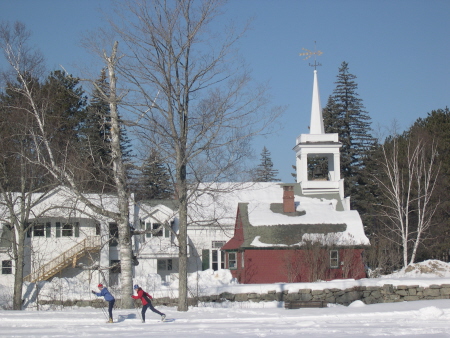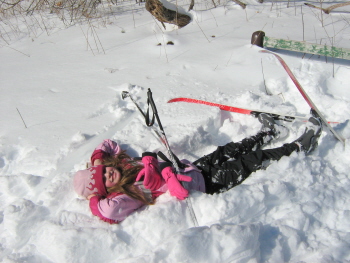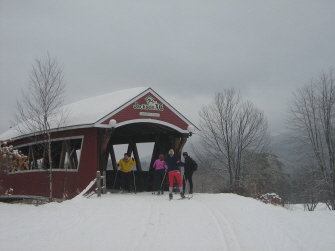Go East
Cross-Country Skier
By Susan Farewell

“Please can we go again, grandpa? Please, please, please?”
“Again pal? Let’s take a break and go have some hot cocoa.”
I happen to overhear this exchange between a young boy (probably about 8) and his pre-baby boomer grandfather in Jackson, New Hampshire last winter. They had just skied “The Wave,” which is a 1.7 kilometer cross-country trail that climbs and dips like a roller coaster, offering a ride-like experience. I too, wanted to do the loop over and over again. I couldn’t get enough of zipping down the hills, gaining enough speed to get me up the next incline.
Most people who have never tried cross-country don’t realize how much fun it is. In fact,
whenever I mention cross-country skiing in my town in Connecticut, someone inevitably brings up the “workout” word. Unlike downhill skiing (which frankly is far more exercise than some people give it credit for), everyone I know seems to think that cross-country skiing is just a lot of work. Indeed, it’s considered major exercise capable of burning  over 650 calories an hour. over 650 calories an hour.
Certainly, cross-country can be a lot of work, especially when you’re just learning how to get around on the long skinny skis. It takes time to get efficient at using the right muscles to maximize your glide. And it can be a lot of work if you want it to be—just try steeper trails, go greater distances, increase your speed or try a bit of backcountry exploring.
One thing you’ll never hear about cross-country skiing in the northeast is the broken-record “It’s better in the west” comment you hear all the time about downhill skiing. That’s because cross-country skiing in the northeast is in a class of its own. Sure, in the west, you can look up and see the massive Rockies or even ski right up to some of Yellowstone’s geysers on cross-country skis. But many western cross-country ski trails are snow-covered forest service roads, which are not as challenging as what eastern skiers take for granted.
Because of the intimate woods and mountains of the northeast, every cross-country center offers its own unique experience and every snowfall presents new challenges, new surprises and new rewards.
In the east, you can find cross-country centers that offer wide open trails bustling with college teams practicing (or racing), others featuring narrow ski paths cut deep into the wilderness. In Lake Placid, you can even practice this sport on the same course that once challenged Olympic contenders.

In some parts of the east, you can cross-county ski as a way of getting around. At Grafton Ponds Nordic Center in Grafton, Vermont, you can ski over to a cheese factory, pause for a tour and tasting before resuming your outing. In Jackson, New Hampshire, you can
ski to restaurants, hotels and shops (some of the local kids even ski to school). And in the western mountains of Maine, you can ski to and stay at an energy-efficient and well- appointed backcountry hut, top off the day with a hot shower and a home-cooked meal to prepare for skiing to another hut the next day. You'll be enjoying Maine Huts & Trails, an ambitious project underway which is a 180-mile-long ski corridor with ski-in huts (right now, there are four huts that are fully functional but in time, there will be a dozen).
But as far as I’m concerned, no matter where I wander on cross-country skis, I can pretty much count on finding peace and serenity. It’s being out in the snowy woods that you can seriously hear the sound of silence and you'll find that in the east, in the west and in wintry lands in between.
Photo credits: Photo on the top of this page by the Jackson Ski Touring Foundation. Other images by Susan Farewell.
|

